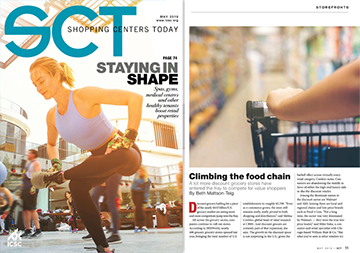Shopping Centers Today, Publish Date: May 1, 2019
 Discount grocers battling for a piece of the nearly $632 billion U.S. grocery market are seeing more and more competitors jump into the fray.
Discount grocers battling for a piece of the nearly $632 billion U.S. grocery market are seeing more and more competitors jump into the fray.
All across the grocery sector, companies continue to roll out stores. According to IBISWorld, nearly 400 grocery stores opened last year, bringing the total number of U.S. establishments to roughly 65,700… Among the dominant names in the discount sector are Walmart and Aldi. Joining them are local and regional chains and low-priced brands such as Food 4 Less… Germany-based Aldi has aggressively added stores over the past five years… Meanwhile, newcomer Lidl has been raising its profile, having entered the U.S. in 2017.
In the May issue of Shopping Centers Today, Beth Mattson-Teig discusses the growth of discounters with industry leaders, including Coreland’s Matt Hammond.
MORE EVOLUTION AHEAD
Discount grocers have stepped in to absorb some of the vacant grocers and big-box stores on the market. Grocery Outlet is one regional chain that prefers second-generation space. In California the company has opened in spaces vacated by Fresh & Easy, Smart & Final and Tops Friendly Markets. Aldi, too, is willing to tale second-generation space. Aldi opened a store last year in a vacated Kmart in Corona, Calif., that was also divided up to accommodate a fitness center and an entertainment site.
Discount grocers seem to be learning from the mistakes of failed chains. One of the reasons Fresh & Easy failed is that it came in with the same model for every location, says Matthew Hammond, a senior vice president and partners at Coreland Cos. “They did it one way for everybody, and, ultimately, they ended up losing out because they didn’t understand their customer.,” he said. of brokerage for Coreland Companies in Tustin, believes many of today’s retail tenants are willing to adapt.
Chains such as Aldi, Grocery Outlet and 99 Cents Only are doing a better job of customizing their inventory to the various demographics, notes Hammond. Grocery Outlet recently opened a store in downtown Los Angeles. Its purchasing power buying surplus goods and overstocks, Hammond observes. The inventory is always changing, make the chain makes a concentrated effort to include organic products that will appeal to the area’s millenials, he shares as an example. “Even in the discount world, these guys are adapting and specializing, which is making them successful.”
For the compete article, go to Shopping Centers Today, May Edition, Page 55.

